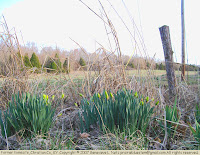Life in Christian County, Kentucky... Life in The Upper South...

In spring here in western Kentucky and across the region, daffodils bloom along the roadsides. Their bright yellow flowers often mark the site where a farmhouse sat years ago. One can only speculate what the farmhouse might have looked like, but it's safe to say that in Christian County, many of them were log houses.
The daffodils in the photo above were planted within the last ten years or so, but they mark an old homesite. An old two-story farmhouse used to stand here and a young couple lived in it. She loved flowers and planted daffodils, iris, and much more. They moved away when the land changed hands, and the new owner recently tore down the old house and the little sheds that had stood around it.
Unlike most of the daffodils that spring up in such places, these are large-blossomed double daffodils. You can tell by their fat buds.
I was amused yesterday to see a photo of old-time simple daffodils in our local newspaper with a caption labeling them as "wildflowers". They are certainly common enough along the roadsides to be a native wildflower, but they were all planted here by human hands, and they don't spread over much of an area naturally. For efficient propagation, the clumps have to be dug up, and the bulbs separated and transplanted.

Technorati tags:
3 comments:
When I lived in northern Alabama, I had a newly built house in an area called Stewart Hollow, which, as the name implies, was a hollow hidden about a mile off the main road. Every spring a line of daffodils sprouted out in the yard. I assume they were planted along a walk or drive at a long-gone house - perhaps even the Stewarts' own. There was no other sign of previous habitation other than a huge, tree-like crape myrtle in a neighboring lot.
Patches of non-native flowers and a mimosa tree grew back in the woods of the lot where I grew up in Falls Church, VA (DC suburbs). The site of the suspected homesite was within 200 feet of a stream. I often imagined a family living there, raising children and planting crops, possibly in the 19th century or even earlier. All physical evidence of habitation had long since returned to Nature, but the flowers still give their silent testimony.
Thank you for your beautiful reminders that we should take time to smell the flowers of life.
Mark, your theory about the location of those flowers seems very likely to me, especially with the crepe myrtle nearby.
Runaway, in Land between the Lakes (50 miles west of here) when TVA bought up the land and moved out hundreds of families in the 1960's, they tore down all the buildings -- every home. It is almost eerie now to see all the daffodils in LBL that mark where homes used to be.
Post a Comment